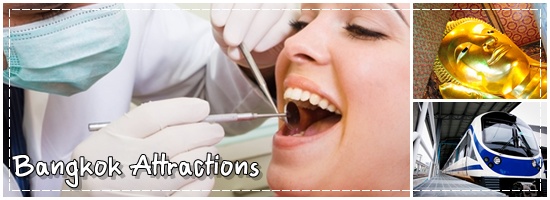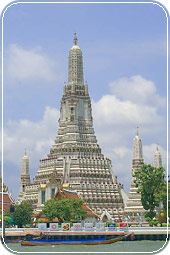
Wat Arun - Temple of Dawn
 The Temple of Dawn or Wat
Arun is name after the Indian god of
dawn, Aruna. It appears in all The
tourist brochures and is located on the
west bank of the Chao Phraya River. King
Taksin chose this 17th century Wat for
his royal temple and palace. The temple
was formerly known as Wat Makok and
renamed to 'Wat Jaeng', literally means
Temple of Dawn, when he restored it. The Temple of Dawn or Wat
Arun is name after the Indian god of
dawn, Aruna. It appears in all The
tourist brochures and is located on the
west bank of the Chao Phraya River. King
Taksin chose this 17th century Wat for
his royal temple and palace. The temple
was formerly known as Wat Makok and
renamed to 'Wat Jaeng', literally means
Temple of Dawn, when he restored it.
The Emerald Buddha was housed here after
it was recaptured from Laos, before
being moved to Wat Phra Kaeo in 1785.
Even without the sacred statue, Wat Arun
continued to be much revered, and the
King Rama II and King Rama III
reconstructed and enlarged the main
prang of the temple to its present
height of 74 metres. King Rama II
renamed it to 'Wat Arunratchatharam' and
King Rama IV later changed the name to 'Wat
Arunratchawanaram'.
Today, Wat Arun has a long, elongated,
Khmer-style, prang, the tower, and four
minor towers symbolising Mount Meru, the
terrestrial representation of the
thirty-three heavens. The Prangs are
covered with pieces of porcelain, which
Chinese boats coming to Bangkok used as
ballast.
The main Prang, steep steps lead to the
two terraces that form the base of the
Prang. The different layers, or heavens,
are supported by Kinnaree, or
half-humans, and frightening Yaksas, or
demons. Pavilions on the first platform
contain statues of the Buddha at the
most important stages of his life, while
on the Hindi god Indra or Erawan, his
thirty-three headed elephant, stand
guard.
Most tourists come for the climb and
don't have time for the rest of the Wat.
The main Buddha image inside the Bot is
believed to have been designed by king
Rama II himself, but the murals date
from the reign of King Rama V.
The temple has flourished
throughout the Ratanakosin period. The
beauty of the architecture and the fine
craftmanship declare its status as a
temple of the first grade and one of the
most outstanding temples of Thailand. In
a long tradition, every king of the
Chakri Dynasty has presided over
important ceremonies here, including the
Royal barge procession to offer Pra
Krathin or monk's robes, during the Thod
Krathin Festival.

|